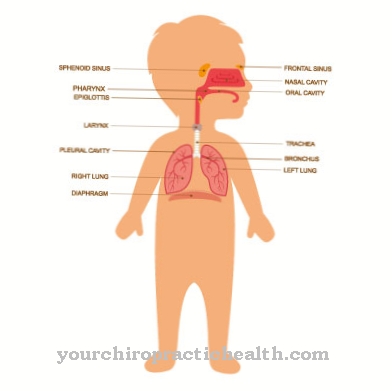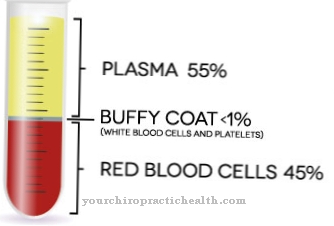At Intertrigo, which means “rubbed sore” in Latin, is an inflammatory skin disease that particularly affects the skin folds. The infection is also known as a "skin wolf". Contributing factors are skin lesions, tight clothing, a lack of hygiene, a humid climate and diseases such as diabetes.
What is intertrigo?

© designua - stock.adobe.com
The skin infection Intertrigo can be seen in various skin folds, for example the feet, armpits, groins, between the toes, in the inner thighs, in the anal folds and under the breasts. Popularly, the red, erosive, itchy, and inflammatory skin lesion is also "Wolf" called.
Intertrigo is caused by mechanical friction in the folds of the skin that causes skin erosion and maceration. Moisture and heat reinforce the mechanism. The opposing surfaces of the skin become reddened and painful. The loss of integrity promotes the growth of bacteria and fungi. Candida albicans is a common fungal pathogen.
Without treatment, the skin usually defends itself in vain. Widespread and weeping inflammations develop. These are aggravated by sweat, urine, feces, vaginal secretions, and other fluids. Infants are also affected by intertrigo, as the hunched posture, short neck and plump body contribute to skin folds.
causes
The eczema can either be of mycotic origin, but it can also be caused by bacteria such as streptococci and staphylococci, candida or dermatophytes. Promoting factors are mainly perspiration (sweating) and maceration through the action of heat. Visiting swimming pools and saunas promotes contamination due to the high humidity here.
Close-fitting clothing and synthetic materials such as nylon also promote the occurrence of the disease. Overweight people and athletes, such as cyclists and hikers, are particularly prone to intertrigo because they sweat more and their skin is often exposed to the effects of rubbing and abrasion. With a fuller body, the skin folds are also particularly pronounced.
This creates a warm, humid climate, which damages the natural protective acid mantle and makes the skin susceptible to pathogens. However, a lack of exercise, for example due to being bedridden or office work, is another risk factor. Diabetic patients are also more likely to develop intertrigo.
Symptoms, ailments & signs
Intertrigo is easy to recognize by the demarcated lesions on the skin that are pink to brown in color. The slight to strong reddening occurs approximately mirror-inverted on both sides of the fold. Purulent crusts can also form on the edges of the skin defects.
As body fluid escapes, itching or burning occurs. The lesions are mostly painful. If the skin infection is caused by fungus, the spots will have a white border. Pustules and papules suggest it is a secondary infection with candida.
The previously damaged skin and the moist and warm environment are an ideal breeding ground for microorganisms, so that secondary infection with various fungi such as candida and dermatophytes, bacteria such as streptococci and viruses is favored.
Diagnosis & course of disease
The diagnosis of intertrigo is made by history, appearance, and examinations. For example, a dermatologist may perform a KOH test to examine the fungal mycelia that are spreading in the skin lesion. Detection of the pathogen is helpful in choosing a suitable therapy.
The relevant rash can provide a good indication of the infection. While bubbles suggest a bacterial infection, scattered papules or pustules around the edges are more likely to be a sign of Candida infection.
Well-defined and very red, foul-smelling rashes without satellite papules raise the suspicion that an infection with streptococci is present. If the risk factors that lead to the onset of intertrigo are not avoided or eliminated, the condition can recur.
Complications
Intertrigo usually causes severe discomfort on the affected person's skin. These complaints often lead to reduced self-esteem or continued inferiority complexes and depression. Patients no longer feel comfortable with their appearance and often avoid social contacts or events as a result.
The skin can also be reddened and the patient suffers from severe itching or burning. These unpleasant feelings can also lead to a general irritability of the person concerned. Pustules and papules also form on the skin and can continue to have a negative impact on the patient's aesthetics.
Further treatment for this disease usually depends on the cause. In most cases, however, there are no particular complications or symptoms and the symptoms go away. Also with the help of Medicines and ointments or creams can limit intertrigo. The life expectancy of the person affected is not reduced with this disease. Furthermore, the patient depends on good personal hygiene so that the disease does not recur.
When should you go to the doctor?
If the redness on the skin persists for more than a few days, it is advisable to see a doctor. Intertrigo should always be clarified by a doctor, because if left untreated, the skin disease can cause serious complications. If there are additional symptoms, a doctor should be consulted immediately. This is especially true when well-being is impaired. Severe itching and bleeding, but also major skin changes, must always be checked by a doctor.
Intertrigo occurs in connection with bacterial infections or obesity. Athletes who wear tight-fitting clothing are also prone to developing sores. A doctor should clarify the symptoms and prescribe an appropriate medication for the patient. Diabetes patients should inform the responsible doctor about the skin changes. If the sores appear to appear for no reason, there may be a serious illness that needs to be clarified by a medical professional. The right place to go is your family doctor or a dermatologist. It is best to go to the pediatrician responsible for children with children.
Treatment & Therapy
Intertrigo can be treated with homeopathic remedies, such as Hepar sulfuris C5. Hydrocotyle C5 is used for toe disease or athlete's foot with red, damp and itchy skin. If the skin lesions are caused by sweating, Dulcamara C5 and sodium sulfuricum C5 are helpful.
If the disease is of mycotic origin, Mercurius 5C is taken. The homeopathic remedy Graphites is the optimal choice for weeping lesions and Hepar sulfuris calcareum 5C for intertrigo of infectious origin with a progressive expansion. Lycopodium clavatum C5 is good for reducing intertrigo when the condition is caused by a superinfected rash.
If intertrigo was caused by Candida albicans, Monilia albicans C5 is used to treat it. Glucocorticoids are anti-inflammatory, making them suitable for treating inflammatory processes. Drying skin care products like zinc ointment are also helpful. Antimycotics and antibiotics can also be used against superinfections.
Without treatment, the skin infection spreads all over the body at a rapid rate. A doctor should therefore be consulted when the first symptoms such as reddish and damp spots appear on the skin folds. The same goes for cracked skin and itching, because these symptoms also indicate intertrigo. Skin care products can help. Oil-in-water emulsions, for example, stabilize the damaged skin barrier and prevent the recurrence of intertrigo.
You can find your medication here
➔ Medicines against redness and eczemaOutlook & forecast
The prognosis of the disease is favorable for a large number of patients. This depends on various factors. These include the cooperation of the person concerned, the general state of health and the use of medical care. A doctor is not always needed. If the intertrigo is triggered due to poor hygiene, daily washing or showering as well as a regular change of clothes can be relieved of symptoms. Wearing tight clothing should also be avoided and can help alleviate skin changes. If overweight is the cause of the disease, the person affected can achieve relief from the existing symptoms by independently changing their diet and optimizing their food consumption.
Weight loss often leads to a minimization of the skin irregularities in these sufferers. If diabetes is the trigger for intertrigo, a doctor should be consulted so that a treatment plan can be drawn up in cooperation with him. Existing complaints are alleviated by the administration of medicines. Long-term therapy is needed in these patients, as in most cases stopping the medication will relapse. The skin disease is triggered by a chronic underlying disease and can therefore usually only be alleviated with adequate therapy.
prevention
The best solution to avoiding intertrigo is called prevention. This can be done by reducing weight, avoiding sweaty drinks such as coffee and avoiding clothing made of synthetic fibers, because cotton is better. Women should also not wear a bra that is too tight. Secondary infections can be prevented with a disinfectant.
Aftercare
In intertrigo, prevention, treatment and aftercare merge. Patients can reduce their risk of disease through weight loss. To avoid excessive sweat production, it also helps to avoid hot drinks and spicy foods. Wearing natural fibers such as cotton ensures good breathability. The clothing should not be too tight to prevent possible irritation.
Special disinfectant products are available to those affected against secondary infections. The doctor informs the patient about the usual treatment with homeopathic medicines. Patients should ensure that they are taken correctly and, if necessary, think about additional measures. Vaseline, talcum powder or ointment help to specifically treat and alleviate the skin disease. There are also special ointments for this, some of which contain cortisone.
According to the doctor's recommendation, patients use skin-friendly, gentle agents to cleanse and care for the affected skin area. Fresh air is very helpful here. A bath with antiseptic ingredients is suitable for killing the germs. If it comes to an open wound, a bandage or plaster is recommended. If an infection does occur, it is important to use the antibiotic prescribed by the doctor correctly. This complements the home remedies already mentioned.
You can do that yourself
With the help of a few resources from the household and nature, intertrigo can be cured yourself in many cases.
The “skin grinder” can be treated with petroleum jelly or talc, for example, either as a powder or as an ointment. Wound ointments (e.g. the Hametum ointment or burn and wound gel) and agents containing cortisone also help with acute complaints. At the same time, the affected area of skin must be cleaned regularly with a skin-friendly disinfectant and, if possible, supplied with fresh air. An antiseptic bath with Bepanthen or Betaisodona kills the germs. A plaster or bandage should be applied to open wounds. In the event of an infection, the doctor must prescribe a suitable antibiotic, which is best used in addition to the home remedies mentioned.
Various globules can be used in homeopathy. For example, the anti-inflammatory preparation Hepar sulfuris C5 has proven itself. If the toes are affected or athlete's foot is present, Hydrocotyle C5 can be used. Dulcamara C5 and Natrum sulfuricum C5 help with skin lesions caused by excessive sweating. If the infection spreads despite everything, a doctor must take care of the treatment.












.jpg)



.jpg)










.jpg)
